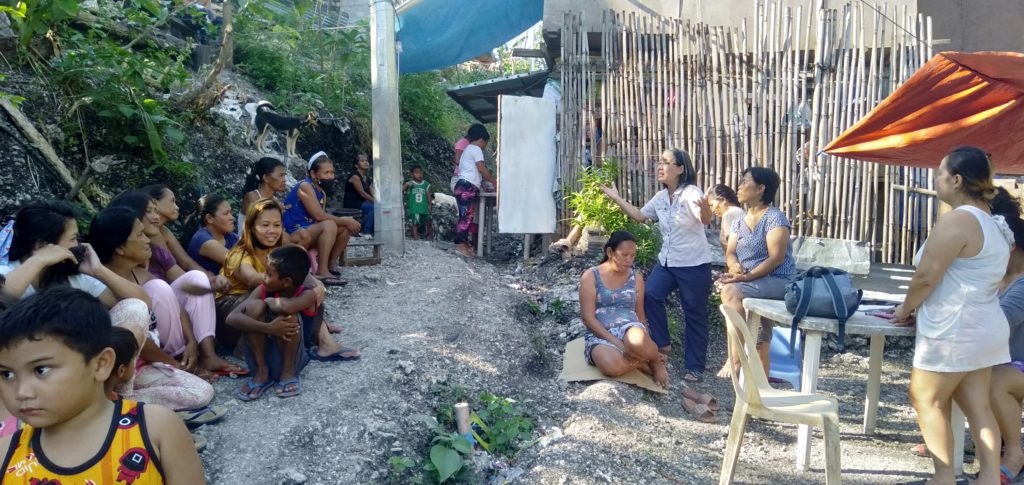By Lilia G. Hernandez, M.D.I arrived in the Philippines March 1st and I would like to share very powerful experiences in the past 2 weeks.
I had not been to Aceh Indonesia after their tsunami or to Haiti after their destructive earthquake. But in the past 10 days, I have been to Leyte and Bohol. The damage here may have been on a lesser scale, the earthquake in Bohol; the typhoon in Leyte. But the disaster cannot be less for the residents.
Tacloban has never been “home” in my heart. However, my father was born there and there grew up a “canto boy” till self-awareness and love brought him to Manila to better himself. To Tacloban he returned on the last 4 years of his life. And there I lived and studied my Pre-Med. All of us emigrated, but 3 nieces and a nephew still live there. So, after a medical mission in the remote barangay Dinaayan in Burauen, Leyte, I went to Tacloban City.
The devastation seen as one drives through the streets, now open but not quite repaired, is so mind numbing, one either gets used to the sight and cease to be affected, or gets so distressed one has to have a sense of humor to stay sane. Some of the highway center islands were made into burial ground with crosses and mourners visible still. Even the coconut trees tell the story: like a woman with disheveled hair blown by the wind from her back, the coconut palms are in one direction, telling of the force and direction of the wind. Many stand like amputated arms reaching out from the ground, probably wailing with the people when the storm passed. Wailing could still be heard where people are trying to rebuild. The day I arrived, people talked of 4 more dead bodies found in San Jose, 4 months to the day after the killer typhoon.
CNN showed a powerful image of a huge red and black cargo ship beached by Yolanda. There is not one but 2 ships, however, one slightly smaller to the right of the well-publicized one. Imagine the people killed when the ship plowed over the houses on its way up the slope of the hill to its current location. Today shanties of tarp and recovered materials have been hastily rebuilt between the shore and the ship. I saw men working on the hull, and one lowering a pail to get water from a well beside the ship. Possibly, that was the community well long before the ship changed the landscape.
Everyone I met in Tacloban had a story to tell. The one that hit closest to home was about Michelle, my niece, who but for a wire attached to a fence, could have drowned. She, her 16 yr. old daughter and 1 yr. old son and the son’s father, Rodel, all live in a squatter area close to the sea, the area swept by the 30 ft. storm surge. She described early morning of Nov 8, 2014, when all of a sudden, the water was up to her neck. She and her daughter tried to cross the street to a fenced park on the slope of a hill. They were able to stand on the fence, holding on to a “wire on the fence” to keep their heads above the water. Rodel and their infant son were helped by the neighbors to cross to the hillside. Mercifully, she said, the water did not stay long, “it was sucked back by the sea”. They then walked higher up the hill towards the City Hall where there were other government buildings. Together with the other survivors they stayed there for over 36 hours, wet and cold, with no food or water. On Sunday (the typhoon hit Friday morning) they started walking to Quarry, the district where her sister and Rodel’s family lived. Michelle and her family suffered the trauma of near death experience; their house, all the food kept in preparation for the typhoon, all their clothing and belongings swept by the storm. What remained was buried in mud. Still hopeful, she retrieved her and her daughter’s uniforms, and tried to wash them back to some decent appearance. All employees and students go to work or school in uniforms. Talk of the resilience of Filipinos! And there are many more sad stories told by the residents but also of compassion and heroism.
Bohol is the island where I live when in the Philippines. Last weekend, I joined a team for a medical mission to Barangay Cambitoon, in Inabanga, close to the epicenter of the 7.2 quake in October. Along the way were the ruins of Bohol’s pride: the 17th century Catholic Churches. Made of cut limestone, the beautiful Loon and Clarin Church were literally pulverized. What remains are mounds of whitish sandy material! I have not seen the ruins of the other churches. Quite visible from the highway are the damaged homes; a few 2 -3 story structures sunk into the earth, with only the top floor visible.
As I sit to meditate on the events of the past 2 weeks, it only helps me to realize again and again, there is a Force greater than man. And there is an inherent goodness in the human heart.
Lilia G. Hernandez, M.D. is a very good friend of the VPHCS and an ardent advocate of community-based health programs in the Philippines. She practices pediatrics in California and visits the Philippines regularly to render her services in the communities served by the VPHCS. She is the President of the Board of Trustees of the Fil-Am Center for Community Health and Development (FACCHD) in Pleasanton, California which has supported the VPHCS since 1995. She is a graduate of the University of Santo Tomas, Class 1974 and a Silver Jubilarian Awardee for Community Service in Philly (1979). She wrote these reflections to her classmates in the[email protected] on Mar 24, 2014.



